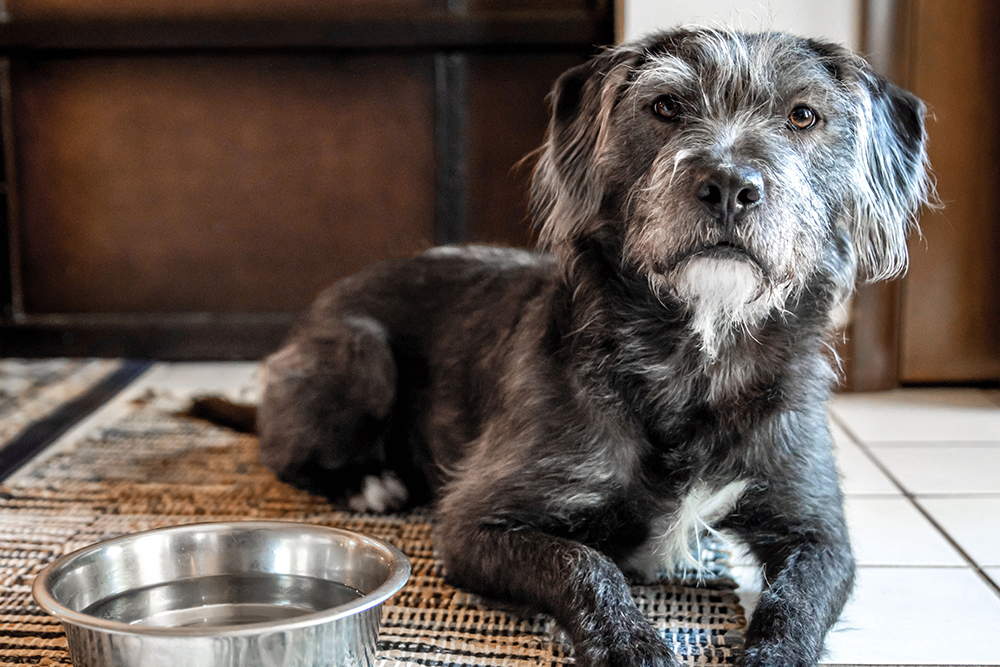By Heidi Clayton
Watching my oldest girl, IchiBan, age has been both a rewarding and terrifying experience. She is 13 years old and has definitely slowed down. Luckily, she is otherwise healthy and is living her best Bull terrier life.
Last weekend, she woke me up. She had started panting, trembling, and struggling to stand up in bed. When I turned the lights on, I immediately saw that her head was tilted to the side. Her eyes were bouncing severely from side to side. The poor old girl was having what is known as vestibular disease. The condition is also known as “old dog vestibular disease” because it is primarily seen in older dogs.
The vestibular system is located in the inner and middle ear. It’s the part of the central nervous system that is responsible for balance and spatial awareness. Vestibular disease occurs when there is a sudden disturbance of balance that can be a result of inflammation of the central nervous system, cancer, ear tumors, stroke, or even just wax build-up in the inner ear.
Symptoms appear all of a sudden. They will include your dog becoming immediately disoriented, wobbly on their feet, or unable to stand at all. Symptoms also include a very obvious head tilt, vomiting, walking in a circle, and nystagmus, which is the bouncing of the eyeball from side to side.
IchiBan appeared to be very dizzy. Her nystagmus was quite severe. As a result, she vomited once. When I stood her up, she walked in a circle.
An episode of vestibular disease in dogs can last for minutes or hours. The best thing you can do at home is to restrict their movement and comfort them. I keep Cerenia (an antiemetic often used for car sickness in dogs) in the house, as well as the sedatives Gabapentin and Trazodone. To help my dog through the event, I gave her the prescribed amount of Cerenia to help with nausea and Gabapentin to relax her so she could sleep. While IchiBan normally sleeps in bed with me, I opted to crate her for the rest of the night so she would not be further injured walking on shaky legs.

Contact your vet if you notice signs of vestibular disease in your dog. For dogs younger than 13 years old, the vet will need to rule out other causes of the symptoms. They might order an X-ray or MRI to make sure there are not any tumors in the brain or ears. They may also check for an ear infection.
In older dogs like IchiBan, the vestibular disease is usually considered idiopathic. That means that the vestibular disease is likely just due to age. For older dogs, treatment is supportive. Since idiopathic vestibular disease often gets better on its own, treatment is just to make your dog feel better in the meantime.
If your older dog has a sudden episode of vestibular disease, don’t panic. The most severe symptoms seem to happen in the first 48 hours.
Slowly, IchiBan is returning to normal. After about 3 days, her eyes were no longer bouncy, her head was less tilted, and she could walk on her own. I opted to take her to see one of her amazing vets, Dr. Amy Hinze at Winslow Animal Hospital, for an acupuncture session and a chiropractic adjustment. I believe it gave her a great deal of relief. Since her head tilt was so severe the first few days after, I think she had a hard time figuring out how to eat from her dish. During that period, I did hand-feed her. She is now able to stand up to eat from her raised food station. In some dogs, the head tilt may be permanent, and they may have a lasting wobble when they walk. IchiBan seems to improve a bit each day. I am giving her whatever supportive care I can and cherishing every moment with my old lady.
If you have any questions, please feel free to email me at heidi@fouronthefloordogtraining.net.
Heidi Clayton started Four On the Floor Dog Training to provide positive, reward-based dog training in South Jersey. She breeds, trains and shows bull terriers under the SoraBully’s Bull Terriers kennel name. Email questions to heidi@fouronthefloordogtraining.net or learn more at https://fouronthefloordogtraining.net
















